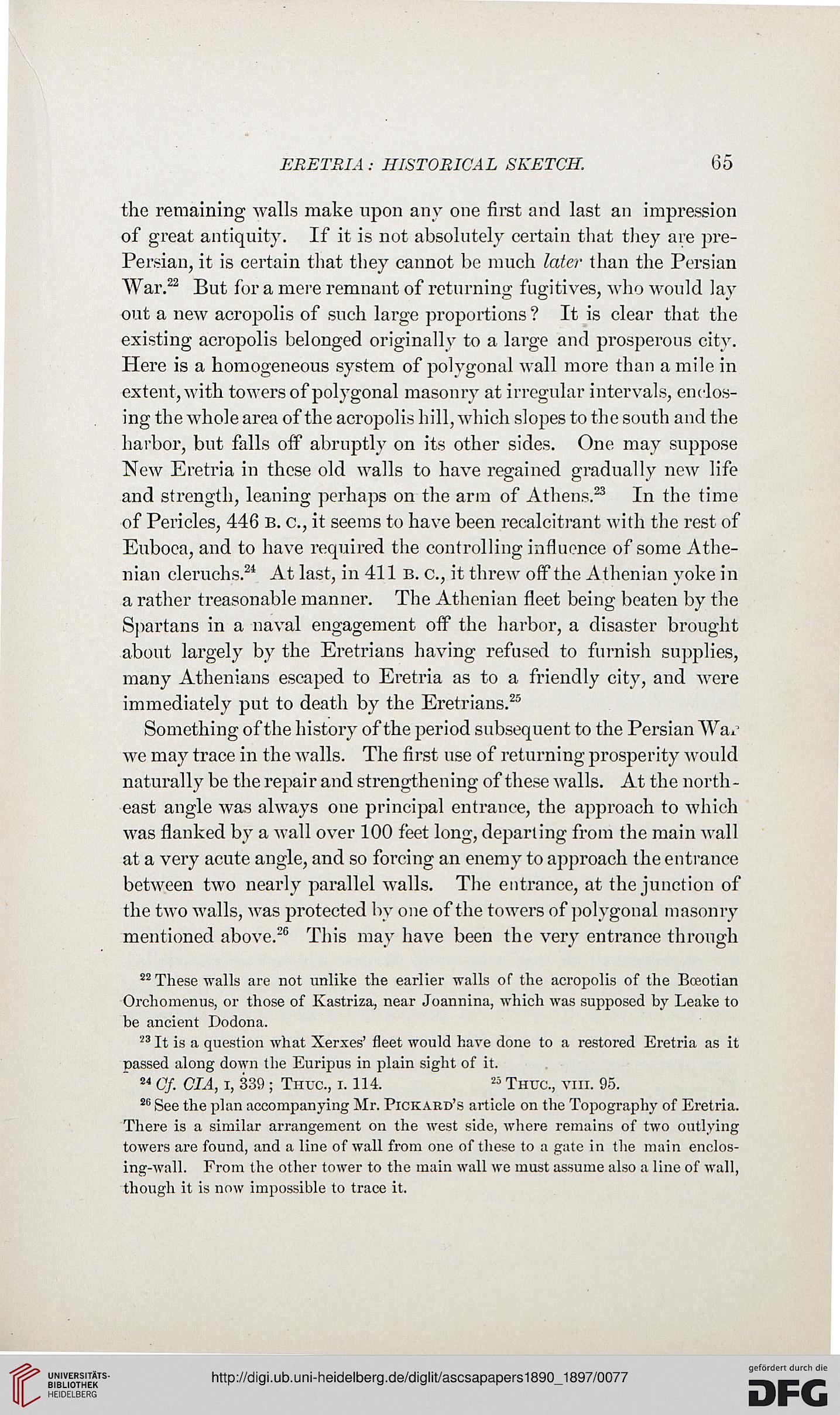ERETRIA : HISTORICAL SKETCH.
65
the remaining Avails make upon any one first and last an impression
of great antiquity. If it is not absolutely certain that they are pre-
Persian, it is certain that they cannot be much later than the Persian
War.22 But for a mere remnant of returning fugitives, who would lay
out a new acropolis of such large proportions ? It is clear that the
existing acropolis belonged originally to a large and prosperous city.
Here is a homogeneous system of polygonal wall more than a mile in
extent, with towers of polygonal masonry at irregular intervals, enclos-
ing the whole area of the acropolis hill, which slopes to the south and the
harbor, but falls off abruptly on its other sides. One may suppose
New Eretria in these old walls to have regained gradually new life
and strength, leaning perhaps on the arm of Athens.23 In the time
of Pericles, 446 b. c, it seems to have been recalcitrant with the rest of
Euboea, and to have required the controlling influence of some Athe-
nian cleruchs.24 At last, in 411 b. c, it threw off the Athenian yoke in
a rather treasonable manner. The Athenian fleet being beaten by the
Spartans in a naval engagement off the harbor, a disaster brought
about largely by the Eretrians having refused to furnish supplies,
many Athenians escaped to Eretria as to a friendly city, and were
immediately put to death by the Eretriaus.25
Something of the history of the period subsequent to the Persian Wa/
we may trace in the Avails. The first use of returning prosperity would
naturally be the repair and strengthening of these walls. At the north-
east angle was always one principal entrance, the approach to which
was flanked by a Avail over 100 feet long, departing from the main Avail
at a very acute angle, and so forcing an enemy to approach the entrance
between two nearly parallel Avails. The entrance, at the junction of
the tAvo Avails, was protected by one of the towers of polygonal masonry
mentioned aboA'e.26 This may havTe been the very entrance through
22 These walls are not unlike the earlier walls of the acropolis of the BtEotian
Orchomenus, or those of Kastriza, near Joannina, which was supposed by Leake to
be ancient Dodona.
23 It is a question what Xerxes' fleet would have done to a restored Eretria as it
passed along down the Euripus in plain sight of it.
24 Of. CIA, i, 339 ; Tnuc, i. 114. 25 Thuc, viii. 95.
26 See the plan accompanying Mr. Pickakd's article on the Topography of Eretria.
There is a similar arrangement on the west side, where remains of two outlying
towers are found, and a line of wall from one of these to a gate in the main enclos-
ing-wall. From the other tower to the main wall we must assume also a line of Avail,
though it is now impossible to trace it.
65
the remaining Avails make upon any one first and last an impression
of great antiquity. If it is not absolutely certain that they are pre-
Persian, it is certain that they cannot be much later than the Persian
War.22 But for a mere remnant of returning fugitives, who would lay
out a new acropolis of such large proportions ? It is clear that the
existing acropolis belonged originally to a large and prosperous city.
Here is a homogeneous system of polygonal wall more than a mile in
extent, with towers of polygonal masonry at irregular intervals, enclos-
ing the whole area of the acropolis hill, which slopes to the south and the
harbor, but falls off abruptly on its other sides. One may suppose
New Eretria in these old walls to have regained gradually new life
and strength, leaning perhaps on the arm of Athens.23 In the time
of Pericles, 446 b. c, it seems to have been recalcitrant with the rest of
Euboea, and to have required the controlling influence of some Athe-
nian cleruchs.24 At last, in 411 b. c, it threw off the Athenian yoke in
a rather treasonable manner. The Athenian fleet being beaten by the
Spartans in a naval engagement off the harbor, a disaster brought
about largely by the Eretrians having refused to furnish supplies,
many Athenians escaped to Eretria as to a friendly city, and were
immediately put to death by the Eretriaus.25
Something of the history of the period subsequent to the Persian Wa/
we may trace in the Avails. The first use of returning prosperity would
naturally be the repair and strengthening of these walls. At the north-
east angle was always one principal entrance, the approach to which
was flanked by a Avail over 100 feet long, departing from the main Avail
at a very acute angle, and so forcing an enemy to approach the entrance
between two nearly parallel Avails. The entrance, at the junction of
the tAvo Avails, was protected by one of the towers of polygonal masonry
mentioned aboA'e.26 This may havTe been the very entrance through
22 These walls are not unlike the earlier walls of the acropolis of the BtEotian
Orchomenus, or those of Kastriza, near Joannina, which was supposed by Leake to
be ancient Dodona.
23 It is a question what Xerxes' fleet would have done to a restored Eretria as it
passed along down the Euripus in plain sight of it.
24 Of. CIA, i, 339 ; Tnuc, i. 114. 25 Thuc, viii. 95.
26 See the plan accompanying Mr. Pickakd's article on the Topography of Eretria.
There is a similar arrangement on the west side, where remains of two outlying
towers are found, and a line of wall from one of these to a gate in the main enclos-
ing-wall. From the other tower to the main wall we must assume also a line of Avail,
though it is now impossible to trace it.




